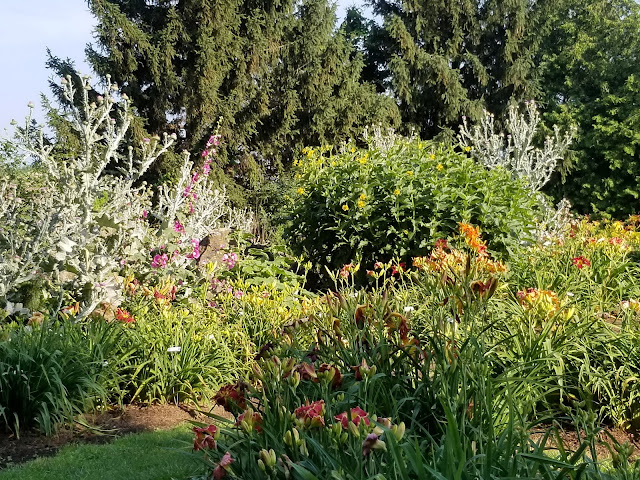T is for Tapioca (Manihot grahamii)
Last year we added a Manihot grahamii or Hardy Tapioca to our tropical garden. You can see it here.
In our garden it dies back to the ground each year, but returns in the spring with a lot of vigor. It's already around 10 feet tall and looking back at pictures from last year, we have at least another three month of growing season for to continue to grow. It typically grows to about 10 feet tall, so I don't expect it to get much taller.
This tropical plant is actually hardy to zone 7b. It is related to the cassava plant, or Manihot esculenta, which is where we get the tapioca we eat. Manihot grahamii is much more hardier than Manihot esculenta, making it a great landscape plant in many locations. It can drop it's leaves and re-grow from both old wood and it's roots. It dies back to the ground in our garden and comes back from the roots.
Manihot grahamii is native to South America and a member of the Euphorbiaceae family. Like many members of this family, it produces a sap that makes it unappealing to many animals. However, bees are attracted to it's flowers.
It needs to be in full to part-sun in a well drained soil. We have ours in part-sun along the back border of the Tropical Garden around the pool. It's lacy open leaves can cast some fun shadows around your garden space. The placement of ours, doesn't really allow for this, but it could be fun up closer to a patio of sunny pathway.
This year we already have blooms and seed heads starting to be produced. I've read in some places not to grow it below zone 8 due to it's ability to re-seed and it's seed dispersal potential. Apparently it opens it's seed pods with enough force that seeds can get cast pretty far from the plant. We are right on the edge of this recommendation. Last year our plant didn't produce any flowers, so this was a non-issue. We'll need to watch what happened this year. If we get a lot of seedlings come spring, we will be sure to remove the seed pods/fruits going forward.
.











I reacted to this post with awe tinged with a slight sense of foreboding. I planted the same Manihot in late June, approximately a week prior to the nuclear heatwave we experienced in early July. Although I positioned it in partial shade, I was pleased and more than a little astounded that the tiny plant survived that heat blast when so many established plants were badly damaged. It continues to look like it's settling in well - maybe too well.
ReplyDeleteI'm sure your be fine. At the very least, you'll have a little extra weeding to do.
DeleteYes, a second one would look fabulous! I love this plant and have grown it but, even though we're in zone 8, it doesn't come back for us. Maybe it doesn't like our wet winters. I kept a specimen in a pot and overwintered it in the greenhouse for a couple of years but this year it died for some reason. Such beautiful leaves!
ReplyDeleteI really love the leaves. Last year I didn't notice any flowers and I'm pretty taken with them too. Sorry yours died.
DeleteYes, I think you need another one. It looks perfect around your pool as it looks so tropical. I never would have guessed it was tapioca.
ReplyDeleteI really want a second one...I just need to figure our a good place.
DeleteOurs in Sacramento comes back from old wood every year, flowers profusely, and self sows EVERYWHERE. I have the same problem with castor beans, another Euphorbia relative. It's a characteristic of this family to have exploding seed pods that fling seed far and wide. I can actually hear the Euphorbia wulfenii seedpods popping when I walk by them in June.
ReplyDeleteWe planted caster beans a few years ago in the tropical garden. At first we stayed on top of the flowers, but it eventually got away from us. Three summers later and I'm still pulling castor bean plants.
DeleteI've never seen Tapioca and now learned what it is. Thanks for telling us about your tropical garden, Rebecca, it beautiful close to the swimming pool. I liked the flowers - they look like of zucchini, I suppose.
ReplyDeleteHave a nice weekend!
I love the flowers too!
DeleteIt's a gorgeous plant, the foliage especially. Like Peter I suspect it would hate our wet winters and we'd definitely be on the borderline of hardy. Sigh!
ReplyDeleteLove that plant. Planted one in the ground here in Portland (Zone 8b), but we had a terrible winter that year (2016-17) and it died a miserable death. Would definitely try again if I came across another one. And yes, I absolutely think you need a second one! As you said, it would look fantastic along the back fence. :)
ReplyDeleteFunny you say we need another one. We had a mild winter, and I found at least 6 that have self seeded into the garden. They are getting potted up this weekend, as we do not want them to become and issue and none of them are in the "right" spot.
Delete